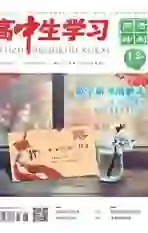推理判断题的解题
2017-03-28籍万杰
籍万杰
在高考阅读理解试题中,推理判断题是仅次于细节理解题的重点题型。该题型主要考查同学们根据文章的字面意思,通过逻辑关系和细节的暗示,推敲作者的态度,理解文章的寓意等。
推理判断题属于主观性较强的高层次阅读理解题。做这类题时,同学们应在理解全文的基础上,从文章本身所提供的信息出发,运用逻辑思维,同时借助一定的常识进行分析、推理、判断。
[命题方式]
在推理判断题题干中常含有表示“表明、暗示、推论”的词汇,如infer,imply,suggest,conclude,learn,intend,mean,show等。有时提问中含有表示推测的情态动词,如can,could,might,would等和其他表示可能性的词,如probably,most likely,seem等。这类试题常以如下句式发问:
1. What can we conclude from this passage?
2. We can infer from the passage that ...
3. Where can you read this passage?
4. From the passage we can draw the conclusion that .
5. From the last paragraph we can infer that .
6. The last sentence of the first paragraph most probably implies that .
7. What would the author probably discuss in the paragraph that follows?
8. Whats the authors attitude towards ...?
9. What is the main purpose of the passage?
[解题思路]
同学们做题时一定要从整体上把握语篇内容,在语篇的表面意义与隐含意义、已知信息与未知信息之间架起桥梁,透过字里行间,去体会作者的“弦外之音”和“言外之意”。具体而言,我们要做到:
首先,抓住文章的主题和细节,分析文章结构,根据上下文的内在联系,挖掘文章的深层含义。在进行推理时,一定要仔细阅读,千万不可脱离原文主观臆断。
其次,对于暗含在文章中的人物的行为动机、事件的因果关系以及作者未言明的倾向等进行合乎逻辑的判断、推理、分析,抓住材料的实质。
再次,在解答推理性问题时,清楚所要解答的问题是针对某个细节进行推断,还是针对主题思想、作者的意图进行推断。如果是针对细节的推断可迅速在阅读材料中确定推理依据的位置或范围,然后再进行推理判断。针对主题思想作推断時,其解题的主要依据是文章的主题思想,然后再分析句子之间的逻辑关系,要区分观点与例证、原因与结果、主观点与次观点。
下面结合高考试题,对推理判断题的不同类型加以解读。
1. 根据特定信息进行推理
有些简单的推理判断题,可根据题干提供的信息,到原文中去抓关键信息,然后进行分析、推理、判断,利用逆向思维或正面推理,从而推断出这句话所隐含的深层含义。
例1 (2016·全国卷I) 27. What did Crosby say about people in the 1960s?
A. They were unsure of themselves.
B. They were eager to raise more children.
C. They wanted to live away from their parents.
D. They had little respect for their grandparents.
解析 C。根据原文第三段“In the 1960s we were all a little wild and couldnt get away from home far enough or fast enough to prove we could do it on our own,” says Christine Crosby ...可以推断,那时候的人不想和父母生活在一起。
2. 整合全文(段)信息进行推断
有些推理判断题,很难从某一句话或某几句话推断出其含义,这时就需要在弄懂全文意思的基础上,整合与题目相关的有用信息,综合起来去推理判断,从而确定最佳结论。
例2 (2016·全国卷Ⅲ) 7. What can we learn about the characters in Weltys fiction?
A. They live in big cities.
B. They are mostly women.
C. They come from real life.
D. They are pleasure seekers.
解析 C。请看原文最后两段:
“I dont make them up,” she said of the characters in her fiction these last 50 or so years. “I dont have to.”
Beauticians, bartenders, piano players and people with purple hats, Weltys people come from afternoons spent visiting with old friends, from walks through the streets of her native Jackson, Miss., from conversations overheard on a bus. It annoys Welty that, at 78, her left ear has now given out. Sometimes, sitting on a bus or a train, she hears only a fragment(片段) of a particularly interesting story.
根据最后两段的描述可以推断出Welty小说中的人物源于真实生活。
3. 利用语境的褒贬性进行信息推断
文章是作者抒发感情、表达观点的一种方式。因此,很多文章,尤其是记叙文和议论文,其语境都有一定的褒贬性,这种褒贬性反映了主人公的特定心理和情绪状态,以及作者的写作意图。利用好文章的语境褒贬性就能在把握主旨的基础上对文章进行准确的逻辑判断。找出反映语境褒贬性及变化的标志性词汇或句子,对我们掌握文章主旨文意,了解主人公的心理特点及发展变化,从而正确地进行逻辑推断很有用处。
例3 (2012·福建卷) 60. How did Percival feel during his meeting with Laura?
A. Angry. B. Calm.
C. Nervous. D. Excited.
解析 C。观察四个选项可以看出,A、C项是贬义词,B、D项是褒义词。因此要注意文章里面所表现的褒贬色彩。根据第一段中的At exactly eleven Sir Percival knocked and entered, with anxiety and worry in every line of his face.,第三段中的His face relaxed a little, but one of his feet kept beating the carpet.以及第七段中的His face went so pale that even his lips lost their color.可以推断,在和Laura见面的过程中,Percival非常“紧张”。
4. 根据上下文的逻辑得出结论
逻辑推论是指严格根据文章中所陈述的事实、论点、例证等一系列论据材料进行推理,从而得出合乎逻辑的结论。解答这类题的前提是获得短文的主题思想或列举的具体事实,然后按题目的要求进行推断。
例4 (2015·湖南卷) 64. What can we conclude about the moving operation of the Tremont Hotel?
A. It went on smoothly as intended.
B. It interrupted the business of the hotel.
C. It involved Pullman turning ten jackscrews.
D. It separated the building from its foundation.
解析 A。根据文章倒数第二段中的... thereby raising the building slowly and evenly. Astonishingly, the Tremont Hotel stayed open during the entire operation, and many of its guests didnt even notice anything was happening.可知,这家旅馆的移动按预期平稳进行。
5. 根据文章中的描述推断下段内容
有些内容文章中没有明确说明,要求同学们根据语篇预测事件可能的结局或下段可能涉及的内容等。做这类题时应把握作者的写作思路(如文章可能按事件发展的经过描写,也可能按因果关系、对比关系来叙述),从而作出合情合理的预测。
例5 (2015·湖北卷) 70. What is the author likely to write about after the last paragraph?
A. Problems with the book.
B. Brookss life experiences.
C. Death of the characters.
D. Brookss translation skills.
解析 A。請看文章最后一段:On the whole, Brookss story is acceptable if uninspired. As one would expect, his writing is mostly clear and, to be fair, some chapters stand out above the rest. I enjoyed, for instance, the chapter in which Harold discovers how to think on his own. While Harold and Erica are certainly not strong or memorable characters, the more serious problems with The Social Animal lie else where. These problems partly involve Brookss attempt to translate his tale into science.
根据该段倒数第二句中的the more serious problems和最后一句中的These problems可知,作者对存在的问题提出了自己的疑问,可以推断文章的下一段应该围绕着problems展开,故选A项。
6. 根据文章体裁和内容推断文章出处
判断文章出处的题目应从文章的体裁和内容来着手。一般来说,报纸上的新闻前面会出现日期、地点或通讯社名称等;广告类文章因其格式特殊,容易辨认;产品说明类文章如器皿、设备的使用说明会有产品名称或操作方式,而药品的服用说明会告知服用时间、次数、药量等;来自网络的文章一般比较新颖,时效性强。
例6 (2015·广东卷) 35. This passage most likely comes from .
A. a fishing guide
B. a popular sales book
C. a novel on childhood
D. a millionaires biography
解析 B。根据最后一段... with great efforts to promote long-term services to people much older and richer than me, I gradually learned what we all need is to think more like customers. It is not an easy job. I will show you how in the following chapters.可知,本文很有可能来自一本有关销售的书。
7. 根据文体特点、用词和语气理解作者写作意图
作者一般不直接陈述自己的意图,而是通过文章所提供的事实和形象,客观地使读者信服某种想法或意见。这种题型不但要求同学们理解文章的内容,还要理解作者阐述问题的写作手法。
不同体裁文章的写作目的不同。故事类记叙文的目的通常是娱乐读者(to entertain);广告类应用文的目的一般是推销产品或服务(to advertise);议论文的目的是要阐述论点(to argue/persuade);科普、文化类说明文的目的大多是介绍知识(to inform)。
例7 (2016·江苏卷) 64. What is the authors purpose in writing the passage?
A. To introduce El Ni?o and its origin.
B. To explain the consequences of El Ni?o.
C. To show ways of fighting against El Ni?o.
D. To urge people to prepare for El Ni?o.
解析 D。根据最后一段中的Since the poorest are least likely to make up for their losses from disasters linked to El Ni?o, reducing their losses needs to be the priority.可知,作者通過此文呼吁人们为厄尔尼诺现象提前作好准备,因此D项正确。
8. 根据作者的思想倾向和感情色彩判断观点态度
所谓作者的观点和态度,就是表达作者对某个话题、行为、事件的看法、感觉或判断。作者的观点和态度一般分为三大类:支持、赞同、乐观;客观、中立;反对、批评、怀疑、悲观。作者的这种思想倾向和感情色彩往往隐含在文章的字里行间。因此,在推断过程中,应特别注意文中作者的措辞,尤其是表达感情色彩的形容词或副词。
例8 (2016·四川卷) 30. What is Gins attitude towards the lives of the indigenous Guianese?
A. Cautious. B. Doubtful.
C. Uninterested. D. Appreciative.
解析 D。根据第三段中的I have a special love for the French Guianese people ... I dont see it as a lawless land. But rather I see it as an area of freedom.可知,Gin非常欣赏圭亚那土著人的生活方式,故选D项。
